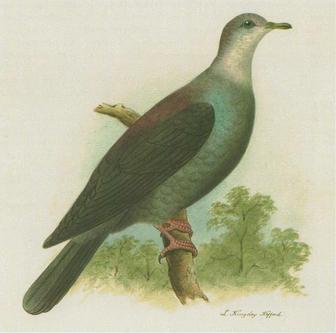Bonin Wood-Pigeon
The Bonin Wood Pigeon was a medium-sized pigeon, with an average length of 45 cm. The upper parts of the Pigeon's body were greyish-black with iridescence except on wing and tail. Crown has a green-purple iridescence, mantle to rump iridescent reflecting violet, amethyst and turquoise. Scapulars and remaining mantle glossed golden green with bronze reflections; wing coverts with dark turquoise green suffused with deep blue. The uppertail of the pigeon coverts broadly tipped with golden green. Breast to belly fringed with deep green and violet iridescence, being strongest on the breast. Iris blue or probably dark blue; bill greenish yellow having a pale tip; legs and the feet were dark red.

The Bonin Wood-Pigeon is classified as Extinct (EX), there is no reasonable doubt that the last individual has died.
The Bonin Wood-pigeon (Columba versicolor) was a pigeon endemic to Nakodo-jima ("Nakondo" is a frequent spelling error) and Chichi-jima in the Ogasawara Islands off the coast of Japan. It is known from four recorded specimens, the first from 1827 and the last from 1889. They averaged a length of 45 cm. This pigeon died out late in the 19th century as a result of deforestation, hunting, and predation by introduced rats and cats. More
Thrush Bonin Wood-Pigeon Pallas's Cormorant Ryukyu Wood-Pigeon Sharpe's Rai l Extinct Birds of Africa Aldabra Brush ... http://www.rlrouse.com/extinct-birds.html Extinct Birds Of The World: ...o; Black mamo; Black-fronted parakeet; Bonin Grosbeak; Bonin Wood pigeon; Brawny great moa; Burley lesser moa; Canarian black oystercatcher; ... http://www.earthlife.net/birds/extinct-list.html Extict Bird List: 1715. Rodrigues Solitaire, Pezophaps solitarius, Rodrigues Is. 1765. Bonin Wood Pigeon, Columba versicolor, Bonin Is. Japan, 1889. Ryukyu ... http://www.earthlife.net/birds/extinction.html Recently Extinct Birds: ... More
a Bonin Wood-pigeon was taken in 1889. Diet: Fruits, seeds and buds. Nesting: Unknown Cool Facts: The Bonin wood-pigeon is recorded from just two islands in the Ogasawara Group-Peel Island, where it was discovered by naturalists travelling with Captain Beechey on the Blossom in 1827, and Nakondo-shima, where the last specimen was taken in 1889. Friedrich von Kittlitz also collected it on Peel in 1828. More
Family : Columbidae
Genus : Columba
Species : versicolor
Authority : Kittlitz, 1832

